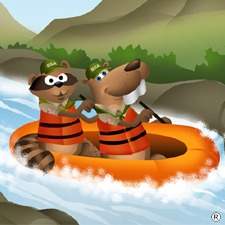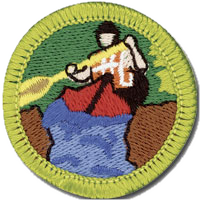Whitewater


Resources
- Whitewater Merit Badge Pamphlet
- Whitewater Merit Badge Class Preparation Page
- Whitewater Merit Badge Workbook
- Scoutmaster Bucky's Merit Badge Advancement Quick Reference
- Scoutmaster Bucky's Acknowledgement Form
Whitewater Requirements
Current Scouts BSA requirements
as of December 6, 2025
as of December 6, 2025
1.
Do the following:
a.
Explain to your counselor the most likely hazards you may encounter
while participating in whitewater activities, including branches and
trees in water along a shore and stretching across the stream, rocks,
hydraulics over ledges or lowhead dams, strong wind, low water or air
temperature, and thunder and lightning storms. Explain what you should
do to anticipate, help prevent, mitigate, and respond to these hazards.
b.
Review with your counselor the prevention, symptoms, and first aid
treatment for the following injuries or illnesses that could occur
while participating in whitewater activities including cold-water
shock; hypothermia; head, neck, and back injuries; heat-related
illnesses; sunburn; dehydration; blisters; bruises; cuts; sprains and
strains; shoulder dislocation; and submersion injuries.
c.
Discuss with your counselor the Scouting America Safety Afloat policy
and the American Whitewater safety guidelines, including the use of
helmet and life jackets.
2.
Do the following:
a.
Demonstrate understanding of the following river features by drawing
lines to show the flow of water: upstream V, downstream V, riffle, eddy
with an eddy line, ledge, river bend, shallows, current at different
depths, drop, horizon line, and hydraulic.
b.
Describe how waves form including standing waves and wave trains.
c.
Explain how to tilt or edge the boat without leaning your body
1.
When entering and exiting an eddy.
2.
When ferrying in downstream and upstream directions.
d.
Explain when, why, and how you should scout a river while ashore, while
on the river, and when you should portage your boat.
a.
If you will be using a canoe to earn this merit badge, demonstrate
strokes and maneuvers from the Canoeing merit badge to the
satisfaction of your counselor.
b.
If you will be using a kayak to earn this merit badge, demonstrate
strokes and maneuvers from the Kayaking merit badge to the
satisfaction of your counselor.
4.
Do ONE of the following:
a.
Option A—Tandem Canoest. (perform the following on calm water):
1.
Demonstrate the following strokes in the bow: cross forward, bow
draw, cross bow draw, bow pry, and sculling draw.
2.
Demonstrate the following strokes in the stern: stern draw, stern
pry, sculling draw, and forward with stern pry.
3.
Demonstrate a high brace, low brace, and righting pry.
b.
Option B—Solo Canoest. (perform the following on calm water):
1.
Demonstrate the following strokes: cross forward, bow draw, cross
bow draw, stern draw, pry, stern pry, sculling draw, and forward
with stern pry.
2.
Demonstrate a high brace, low brace, and righting pry.
c.
Option C—Solo Kayaker. (perform the following on calm water):
1.
Demonstrate the following strokes: bow draw, rudder, and sculling
draw.
2.
Demonstrate a high brace and low brace.
5.
Do the following:
a.
Explain the International Scale of River Difficulty and apply the scale
to the stretch of river approved by your counselor.
b.
Identify the specific characteristics of the river that are factors in
your classification according to the International Scale.
c.
Discuss how the level of flow changes a river from one class to another
and what effects different flow rates have on the features of a river
and its hazards.
6.
Explain the importance of communication during every whitewater outing.
Demonstrate knowledge and ability to use the following American Whitewater
Universal River Signals, both visual and auditory: "Stop," "Are you OK?,"
"Help/emergency," "Run river right," "Run river left," and "All clear—come
ahead."
7.
Do ONE of the following:
a.
If completing this merit badge in a canoe, describe the various types
of canoes used on moving water and how they differ in design,
materials, and purpose.
b.
If completing this merit badge in a kayak, describe the various types
of kayaks used on moving water and explain how they differ in design,
materials, and purpose.
8.
Review with your counselor the personal and group equipment necessary for a
safe whitewater outing and how and why it is used.
9.
Demonstrate your ability to read a Class II section of river approved by
your counselor. Describe the most desirable paths or lines of travel as
well as alternative routes and options. Point out how to use the existing
water features to your advantage, and explain how to best avoid the hazards
present.
10.
Wearing a proper life jacket and being appropriately dressed for the
weather and water conditions, perform the following skills in moving water
in a properly equipped whitewater craft of your choice (tandem canoe, solo
canoe, or solo kayak). If a tandem canoe is used, the skills must be
demonstrated from both the bow and stern positions.
a.
Launch and land.
b.
Paddle forward in a straight line at least 10 boat lengths.
c.
Backpaddle in a straight line at least five boat lengths.
d.
Ferry upstream from both sides of the river.
e.
Ferry downstream from both sides of the river.
f.
Eddy turn from both sides of an eddy.
g.
Peel out from both sides of an eddy.
11.
Explain and demonstrate the following to your counselor:
a.
Self-rescue and procedures when capsized in moving water, including a
wet exit if necessary
b.
Proper use of a throw rope to rescue a swimmer in whitewater
c.
Proper technique for receiving a throw rope as a swimmer
d.
Portaging-where portaging would be appropriate, and when and how to do
it
e.
The whitewater buddy system using at least three persons and three
craft.
12.
Participate in one or more whitewater trips using either a canoe or kayak
on a Class I and/or Class II river. The trip(s) must involve at least six
hours of paddling time. For each trip:
a.
Help to prepare a written plan, specifying the route (put-ins and
takeouts), schedule, equipment, safety precautions, and emergency
procedures.
b.
Determine local rules and obtain permission from landowners and land
managers in advance.
c.
Explain what steps have been taken to comply with Scouting America
Safety Afloat and the American Whitewater safety guidelines.
d.
Show how to protect personal and group equipment from water and how to
load and secure the containers in boats to be used in the trip. Execute
the plans with other paddlers.
e.
Explain to your counselor how well your plans worked for each trip
taken.